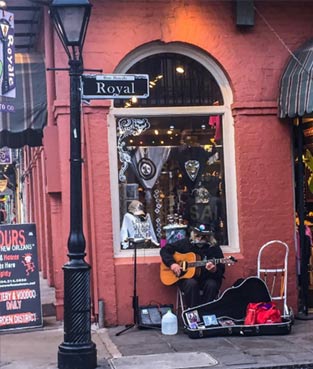Marigny
Residents of the Faubourg (an ancient French term for "suburb") Marigny are very proud of their neighborhood...and who can blame them?
Here in this small wedge of real estate located just downriver from the French Quarter, you'll find everything that makes New Orleans a uniquely wonderful place. The jazz clubs lining Frenchmen Street are world-famous, and every night you can hear big-name acts jamming with the hippest stars of tomorrow. The Marigny is home to some of the city's trendiest restaurants: places where new chefs constantly reinvent the city's cuisine. Neighborhood galleries and antique stories offer gems for every pocketbook, from museum-quality art to thrift-shop chic. And the area's eclectic late Georgian, Creole, and Greek Revival houses nestle closely together, forming a fascinating and varied cityscape.
The Marigny's boundaries as defined by the City Planning Commission are: North Rampart Street and St. Claude Avenue to the north, Franklin Avenue to the east, the Mississippi River to the south and Esplanade Avenue to the west.
The Marigny was laid out in the first decade of the 19th century by eccentric Creole millionaire developer Bernard Xavier Philippe de Marigny de Mandeville on land that had been his family plantation, just downriver from the old city limits of New Orleans. The portion of the Marigny closer to the river was built up first; the area on the side of St. Claude Avenue (formerly "Goodchildren Street") away from the river was sometimes called "New Marigny". In the early 19th century, New Marigny was where white Creole gentlemen set up households for their mistresses of color (and their offspring) in the tradition of "plaçage."
Broad Elysian Fields Avenue, named after the Champs-Élysées in Paris, was designed to be the main street of the Faubourg Marigny. It was the first street in New Orleans to extend all the way from the riverfront straight to Lake Pontchartrain, 8 km (5 miles) away. From 1830-31, the Pontchartrain Railroad was built, with tracks running down the center of Elysian Fields. The area at the other end of the rail line developed into Milneburg. Marigny's town square, Washington Square, fronts Elysian Fields.
The neighborhood declined badly in the mid-20th century, but came back strong in the late 20th century. Profiteering centered around the 1984 World's Fair drove many long-term residents from the French Quarter into the Marigny. Frenchmen Street soon developed the city's premier collection of live music venues and restaurants, and is a popular destination for both locals and knowledgeable out-of-towners.



